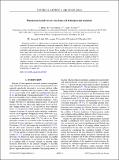Fluctuation-based fracture mechanics of heterogeneous materials
Author(s)
Mulla, T; Pellenq, RJ-M; Ulm, F-J
DownloadPublished version (3.520Mb)
Publisher Policy
Publisher Policy
Article is made available in accordance with the publisher's policy and may be subject to US copyright law. Please refer to the publisher's site for terms of use.
Terms of use
Metadata
Show full item recordAbstract
We present results of a hybrid analytical-simulation investigation of the fracture resistance of heterogeneous materials. We show that bond-energy fluctuations sampled by Monte Carlo simulations in the semigrand canonical ensemble provide a means to rationalize the complexity of heterogeneous fracture processes, encompassing probability and percolation theories of fracture. For a number of random and textured model materials, we derive upper and lower bounds of fracture resistance and link bond fracture fluctuations to statistical descriptors of heterogeneity, such as two-point correlation functions, to identify the origin of toughening mechanisms. This includes a shift from short- to long-range interactions of bond fracture processes in random systems to the transition from critical to subcritical bond fracture percolation in textured materials and the activation of toughness reserves at compliant interfaces. Induced by elastic mismatch, they connect to a number of disparate experimental observations, including toughening of brittle solids by deformable polymers or organics in, e.g., gas shale, nacre; stress-induced transformational toughening in ceramics; and toughening of sparse elastic networks in hydrogels, to name a few.
Date issued
2022-12Department
Massachusetts Institute of Technology. Department of Civil and Environmental EngineeringJournal
Physical Review E
Publisher
American Physical Society (APS)
Citation
Mulla, T, Pellenq, RJ-M and Ulm, F-J. 2022. "Fluctuation-based fracture mechanics of heterogeneous materials." Physical Review E, 106 (6).
Version: Final published version